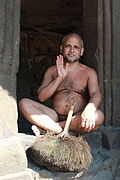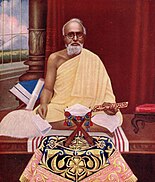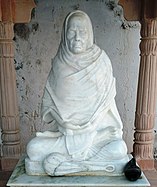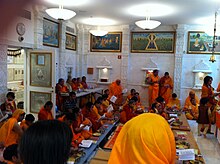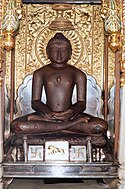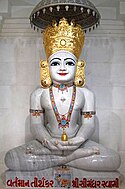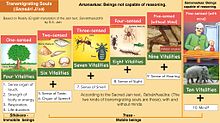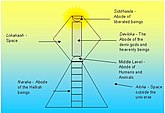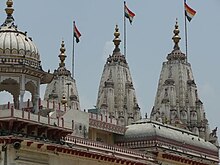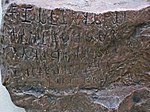Jainism
| Part of a series on |
| Jainism |
|---|
 |
|
Jain prayers |
|
Ethics |
|
Major sects |
|
Festivals |
|
|
Jainism (/ˈdʒeɪnɪzəm/),[1] traditionally known as Jain Dharma, is an ancient Indian religion. Followers of Jainism are called "Jains", a word derived from the Sanskrit word jina, meaning "victor". Jains trace their spiritual ideas and history through a succession of twenty-four leaders or tirthankaras, with the first being Rishabhanatha, who according to Jain tradition lived millions of years ago, the twenty-third tirthankara Parshvanatha in 900 BCE, and the twenty-fourth tirthankara the Mahāvīra around 500 BCE. Jains believe that Jainism is an eternal dharma with the tirthankaras guiding every cycle of the Jain cosmology. Their canonical religious texts are called Agamas.
The main religious premises of Jainism are ahiṃsā (non-violence), anekāntavāda (many-sidedness), aparigraha (non-attachment) and asceticism. Devout Jains take five main vows: ahiṃsā (non-violence), satya (truth), asteya (not stealing), brahmacharya (sexual continence), and aparigraha (non-possessiveness). These principles have affected Jain culture in many ways, such as leading to a predominantly vegetarian lifestyle. Parasparopagraho Jīvānām (the function of souls is to help one another) is its motto and the Ṇamōkāra mantra is its most common and basic prayer.
Jainism has two major ancient sub-traditions, Digambaras and Śvētāmbaras, with different views on ascetic practices, gender and which texts can be considered canonical; both have mendicants supported by laypersons (śrāvakas). The religion has between four and five million followers, mostly in India. Outside India, some of the largest communities are in Canada, Europe, and the United States. Jainism is growing in Japan, where more than 5,000 ethnic Japanese families have converted to Jainism. Major festivals include Paryushana and Daslakshana, Ashtanika, Mahavir Janma Kalyanak, and Dipawali.
Main principles[edit]
Non-violence (ahimsa)[edit]

The principle of ahimsa (non-violence or non-injury) is a fundamental tenet of Jainism.[2] It holds that one must abandon all violent activity and that without such a commitment to non-violence all religious behavior is worthless.[2] In Jain theology, it does not matter how correct or defensible the violence may be, one must not kill or harm any being, and non-violence is the highest religious duty.[2][3] Jain texts such as Acaranga Sūtra and Tattvarthasūtra state that one must renounce all killing of living beings, whether tiny or large, movable or immovable.[4][5] Its theology teaches that one must neither kill another living being, nor cause another to kill, nor consent to any killing directly or indirectly.[4][3] Furthermore, Jainism emphasizes non-violence against all beings not only in action but also in speech and in thought.[4][5] It states that instead of hate or violence against anyone, "all living creatures must help each other".[5][a] Jains believe that violence negatively affects and destroys one's soul, particularly when the violence is done with intent, hate or carelessness, or when one indirectly causes or consents to the killing of a human or non-human living being.[5]
The doctrine exists in Hinduism and Buddhism, but is most highly developed in Jainism.[2][7][8][9][10][11] The theological basis of non-violence as the highest religious duty has been interpreted by some Jain scholars not to "be driven by merit from giving or compassion to other creatures, nor a duty to rescue all creatures", but resulting from "continual self-discipline", a cleansing of the soul that leads to one's own spiritual development which ultimately affects one's salvation and release from rebirths.[12] Jains believe that causing injury to any being in any form creates bad karma which affects one's rebirth, future well being and causes suffering.[13][14]
Late medieval Jain scholars re-examined the Ahiṃsā doctrine when faced with external threat or violence. For example, they justified violence by monks to protect nuns.[15][16] According to Dundas, the Jain scholar Jinadattasuri wrote during a time of Muslim destruction of temples and persecution that "anybody engaged in a religious activity who was forced to fight and kill somebody would not lose any spiritual merit but instead attain deliverance".[17] However, examples in Jain texts that condone fighting and killing under certain circumstances are relatively rare.[15][b]
Many-sided reality (anekāntavāda)[edit]

The second main principle of Jainism is anekāntavāda,[19][20] from anekānta ("many-sidedness") and vada ("doctrine").[19][20] The doctrine states that truth and reality are complex and always have multiple aspects. It further states that reality can be experienced, but cannot be fully expressed with language. It suggests that human attempts to communicate are Naya, "partial expression of the truth".[19] According to it, one can experience the taste of truth, but cannot fully express that taste through language. It holds that attempts to express experience are syāt, or valid "in some respect", but remain "perhaps, just one perspective, incomplete".[21] It concludes that in the same way, spiritual truths can be experienced but not fully expressed.[19] It suggests that the great error is belief in ekānta (one-sidedness), where some relative truth is treated as absolute.[22] The doctrine is ancient, found in Buddhist texts such as the Samaññaphala Sutta. The Jain Agamas suggest that Mahāvīra's approach to answering all metaphysical philosophical questions was a "qualified yes" (syāt).[23][24] These texts identify anekāntavāda as a key difference from the Buddha's teachings. The Buddha taught the Middle Way, rejecting extremes of the answer "it is" or "it is not" to metaphysical questions. The Mahāvīra, in contrast, taught his followers to accept both "it is", and "it is not", qualified with "perhaps", to understand Absolute Reality.[25] The permanent being is conceptualized as jiva (soul) and ajiva (matter) within a dualistic anekāntavāda framework.[26]
According to Paul Dundas, in contemporary times the anekāntavāda doctrine has been interpreted by some Jains as intending to "promote a universal religious tolerance", and a teaching of "plurality" and "benign attitude to other [ethical, religious] positions". Dundas states this is a misreading of historical texts and Mahāvīra's teachings.[27] According to him, the "many pointedness, multiple perspective" teachings of the Mahāvīra is about the nature of absolute reality and human existence.[28] He claims that it is not about condoning activities such as killing animals for food, nor violence against disbelievers or any other living being as "perhaps right".[27] The five vows for Jain monks and nuns, for example, are strict requirements and there is no "perhaps" about them.[29] Similarly, since ancient times, Jainism co-existed with Buddhism and Hinduism according to Dundas, but Jainism disagreed, in specific areas, with the knowledge systems and beliefs of these traditions, and vice versa.[30]
Non-attachment (aparigraha)[edit]
The third main principle in Jainism is aparigraha which means non-attachment to worldly possessions.[31] For monks and nuns, Jainism requires a vow of complete non-possession of any property, relations and emotions.[32] The ascetic is a wandering mendicant in the Digambara tradition, or a resident mendicant in the Śvētāmbara tradition.[32] For Jain laypersons, it recommends limited possession of property that has been honestly earned, and giving excess property to charity.[31] According to Natubhai Shah, aparigraha applies to both the material and the psychic. Material possessions refer to various forms of property. Psychic possessions refer to emotions, likes and dislikes, and attachments of any form. Unchecked attachment to possessions is said to result in direct harm to one's personality.[33]
Jain ethics and five vows[edit]
Jainism teaches five ethical duties, which it calls five vows. These are called anuvratas (small vows) for Jain laypersons, and mahavratas (great vows) for Jain mendicants.[34] For both, its moral precepts preface that the Jain has access to a guru (teacher, counsellor), deva (Jina, god), doctrine, and that the individual is free from five offences: doubts about the faith, indecisiveness about the truths of Jainism, sincere desire for Jain teachings, recognition of fellow Jains, and admiration for their spiritual pursuits.[35] Such a person undertakes the following Five vows of Jainism:
- Ahiṃsā, "intentional non-violence" or "noninjury":[35] The first major vow taken by Jains is to cause no harm to other human beings, as well as all living beings (particularly animals).[35] This is the highest ethical duty in Jainism, and it applies not only to one's actions, but demands that one be non-violent in one's speech and thoughts.[36][37]
- Satya, "truth": This vow is to always speak the truth. Neither lie, nor speak what is not true, and do not encourage others or approve anyone who speaks an untruth.[36][34]
- Asteya, "not stealing": A Jain layperson should not take anything that is not willingly given.[35][38] Additionally, a Jain mendicant should ask for permission to take it if something is being given.[39]
- Brahmacharya, "celibacy": Abstinence from sex and sensual pleasures is prescribed for Jain monks and nuns. For laypersons, the vow means chastity, faithfulness to one's partner.[36][34]
- Aparigraha, "non-possessiveness": This includes non-attachment to material and psychological possessions, avoiding craving and greed.[34] Jain monks and nuns completely renounce property and social relations, own nothing and are attached to no one.[31][40]
Jainism prescribes seven supplementary vows, including three guņa vratas (merit vows) and four śikşā vratas.[41][42] The Sallekhana (or Santhara) vow is a "religious death" ritual observed at the end of life, historically by Jain monks and nuns, but rare in the modern age.[43] In this vow, there is voluntary and gradual reduction of food and liquid intake to end one's life by choice and with dispassion,[44][45] This is believed to reduce negative karma that affects a soul's future rebirths.[46]
Practices[edit]
Asceticism and monasticism[edit]
Of the major Indian religions, Jainism has had the strongest ascetic tradition.[47][48][49] Ascetic life may include nakedness, symbolizing non-possession even of clothes, fasting, body mortification, and penance, to burn away past karma and stop producing new karma, both of which are believed essential for reaching siddha and moksha ("liberation from rebirths" and "salvation").[47][50][51]
Jain texts like Tattvartha Sūtra and Uttaradhyayana Sūtra discuss austerities in detail. Six outer and six inner practices are oft-repeated in later Jain texts.[52] Outer austerities include complete fasting, eating limited amounts, eating restricted items, abstaining from tasty foods, mortifying the flesh, and guarding the flesh (avoiding anything that is a source of temptation).[53] Inner austerities include expiation, confession, respecting and assisting mendicants, studying, meditation, and ignoring bodily wants in order to abandon the body.[53] Lists of internal and external austerities vary with the text and tradition.[54][55] Asceticism is viewed as a means to control desires, and to purify the jiva (soul).[49] The tirthankaras such as the Mahāvīra (Vardhamana) set an example by performing severe austerities for twelve years.[56][57][58]
Monastic organization, sangh, has a four-fold order consisting of sadhu (male ascetics, muni), sadhvi (female ascetics, aryika), śrāvaka (laymen), and śrāvikā (laywomen). The latter two support the ascetics and their monastic organizations called gacch or samuday, in autonomous regional Jain congregations.[59][60][61] Jain monastic rules have encouraged the use of mouth cover, as well as the Dandasan – a long stick with woolen threads – to gently remove ants and insects that may come in their path.[62][63][64]
Food and fasting[edit]
The practice of non-violence towards all living beings has led to Jain culture being vegetarian. Devout Jains practice lacto-vegetarianism, meaning that they eat no eggs, but accept dairy products if there is no violence against animals during their production. Veganism is encouraged if there are concerns about animal welfare.[65] Jain monks, nuns and some followers avoid root vegetables such as potatoes, onions, and garlic because tiny organisms are injured when the plant is pulled up, and because a bulb or tuber's ability to sprout is seen as characteristic of a higher living being.[66][c]
Jains fast particularly during festivals.[67] This practice is called upavasa, tapasya or vrata,[68] and may be practiced according to one's ability.[69] Digambaras fast for Dasa-laksana-parvan, eating only one or two meals per day, drinking only boiled water for ten days, or fasting completely on the first and last days of the festival,[70] mimicking the practices of a Jain mendicant for the period.[70] Śvētāmbara Jains do similarly in the eight day paryusana with samvatsari-pratikramana.[71] The practice is believed to remove karma from one's soul and provides merit (punya).[67] A "one day" fast lasts about 36 hours, starting at sunset before the day of the fast and ending 48 minutes after sunrise the day after.[67] Among laypeople, fasting is more commonly observed by women, as it shows her piety and religious purity, gains merit earning and helps ensure future well-being for her family. Some religious fasts are observed in a social and supportive female group.[72] Long fasts are celebrated by friends and families with special ceremonies.[72]
Meditation[edit]
Jainism considers meditation (dhyana) a necessary practice, but its goals are very different from those in Buddhism and Hinduism.[73] In Jainism, meditation is concerned more with stopping karmic attachments and activity, not as a means to transformational insights or self-realization in other Indian religions.[73] According to Padmanabh Jaini, Sāmāyika is a practice of "brief periods in meditation" in Jainism that is a part of siksavrata (ritual restraint).[74] The goal of Sāmāyika is to achieve equanimity, and it is the second siksavrata.[d] The samayika ritual is practiced at least three times a day by mendicants, while a layperson includes it with other ritual practices such as Puja in a Jain temple and doing charity work.[75][76][77] According to Johnson, as well as Jaini, samayika connotes more than meditation, and for a Jain householder is the voluntary ritual practice of "assuming temporary ascetic status".[78][e]
Rituals and worship[edit]

There are many rituals in Jainism's various sects. According to Dundas, the ritualistic lay path among Śvētāmbara Jains is "heavily imbued with ascetic values", where the rituals either revere or celebrate the ascetic life of Tirthankaras, or progressively approach the psychological and physical life of an ascetic.[80][81] The ultimate ritual is sallekhana, a religious death through ascetic abandonment of food and drinks.[80] The Digambara Jains follow the same theme, but the life cycle and religious rituals are closer to a Hindu liturgy.[80] The overlap is mainly in the life cycle (rites-of-passage) rituals, and likely developed because Jain and Hindu societies overlapped, and rituals were viewed as necessary and secular.[82][83]
Jains ritually worship numerous deities,[81] especially the Jinas. In Jainism a Jina as deva is not an avatar (incarnation), but the highest state of omniscience that an ascetic tirthankara achieved.[84] Out of the 24 Tirthankaras, Jains predominantly worship four: Mahāvīra, Parshvanatha, Neminatha and Rishabhanatha.[85] Among the non-tirthankara saints, devotional worship is common for Bahubali among the Digambaras.[86] The Panch Kalyanaka rituals remember the five life events of the tirthankaras, including the Panch Kalyanaka Pratishtha Mahotsava, Panch Kalyanaka Puja and Snatrapuja.[87][88]

The basic ritual is darsana (seeing) of deva, which includes Jina,[90] or other yaksas, gods and goddesses such as Brahmadeva, 52 Viras, Padmavati, Ambika and 16 Vidyadevis (including Sarasvati and Lakshmi).[91][92][93] Terapanthi Digambaras limit their ritual worship to Tirthankaras.[94] The worship ritual is called devapuja, and is found in all Jain sub-traditions.[95] Typically, the Jain layperson enters the temple inner sanctum in simple clothing and bare feet with a plate filled with offerings, bows down, says the namaskar, completes his or her litany and prayers, sometimes is assisted by the temple priest, leaves the offerings and then departs.[95]
Jain practices include performing abhisheka (ceremonial bath) of the images.[96] Some Jain sects employ a pujari (also called upadhye), who may be a Hindu, to perform priestly duties at the temple.[97][98] More elaborate worship includes offerings such as rice, fresh and dry fruits, flowers, coconut, sweets, and money. Some may light up a lamp with camphor and make auspicious marks with sandalwood paste. Devotees also recite Jain texts, particularly the life stories of the tirthankaras.[99][89]
Traditional Jains, like Buddhists and Hindus, believe in the efficacy of mantras and that certain sounds and words are inherently auspicious, powerful and spiritual.[100][101] The most famous of the mantras, broadly accepted in various sects of Jainism, is the "five homage" (panca namaskara) mantra which is believed to be eternal and existent since the first tirthankara's time.[100][102] Medieval worship practices included making tantric diagrams of the Rishi-mandala including the tirthankaras.[103] The Jain tantric traditions use mantra and rituals that are believed to accrue merit for rebirth realms.[104]
Festivals[edit]
The most important annual Jain festival is called the Paryushana by Svetambaras and Dasa lakshana parva by the Digambaras. It is celebrated from the 12th day of the waning moon in the traditional lunisolar month of Bhadrapada in the Indian calendar. This typically falls in August or September of the Gregorian calendar.[105][106] It lasts eight days for Svetambaras, and ten days among the Digambaras.[105] It is a time when lay people fast and pray. The five vows are emphasized during this time.[106] Svetambaras recite the Kalpasūtras, while Digambaras read their own texts. The festival is an occasion where Jains make active effort to stop cruelty towards other life forms, freeing animals in captivity and preventing the slaughter of animals.[105]
I forgive all living beings,
may all living beings forgive me.
All in this world are my friends,
I have no enemies.
— Jain festival prayer on the last day[107]
The last day involves a focused prayer and meditation session known as Samvatsari. Jains consider this a day of atonement, granting forgiveness to others, seeking forgiveness from all living beings, physically or mentally asking for forgiveness and resolving to treat everyone in the world as friends.[105] Forgiveness is asked by saying "Micchami Dukkadam" or "Khamat khamna" to others. This means, "If I have offended you in any way, knowingly or unknowingly, in thought, word or action, then I seek your forgiveness." The literal meaning of Paryushana is "abiding" or "coming together".[108]
Mahavir Janma Kalyanak celebrates the birth of Mahāvīra. It is celebrated on the 13th day of the lunisolar month of Chaitra in the traditional Indian calendar. This typically falls in March or April of the Gregorian calendar.[109][110] The festivities include visiting Jain temples, pilgrimages to shrines, reading Jain texts and processions of Mahāvīra by the community. At his legendary birthplace of Kundagrama in Bihar, north of Patna, special events are held by Jains.[109] Dipawali is observed by Jains as the anniversary of Mahāvīra's attainment of moksha.[111] The Hindu festival of Diwali is also celebrated on the same date (Kartika Amavasya). Jain temples, homes, offices, and shops are decorated with lights and diyas (small oil lamps). The lights are symbolic of knowledge or removal of ignorance. Sweets are often distributed. On Diwali morning, Nirvan Ladoo is offered after praying to Mahāvīra in all Jain temples across the world. The Jain new year starts right after Diwali.[111] Some other festivals celebrated by Jains are Akshaya Tritiya and Raksha Bandhan, similar to those in the Hindu communities.[112][113]
Traditions and sects[edit]
The Jain community is divided into two major denominations, Digambara and Śvētāmbara. Monks of the Digambara (sky-clad) tradition do not wear clothes. Female monastics of the Digambara sect wear unstitched plain white sarees and are referred to as Aryikas. Śvētāmbara (white-clad) monastics, on the other hand, wear seamless white clothes.[114]
During Chandragupta Maurya's reign, Jain tradition states that Acharya Bhadrabahu predicted a twelve-year-long famine and moved to Karnataka with his disciples. Sthulabhadra, a pupil of Acharya Bhadrabahu, is believed to have stayed in Magadha.[115] Later, as stated in tradition, when followers of Acharya Bhadrabahu returned, they found those who had remained at Magadha had started wearing white clothes, which was unacceptable to the others who remained naked.[116] This is how Jains believe the Digambara and Śvētāmbara schism began, with the former being naked while the latter wore white clothes.[117] Digambara saw this as being opposed to the Jain tenet of aparigraha which, according to them, required not even possession of clothes, i.e. complete nudity. In the 5th-century CE, the Council of Valabhi was organized by Śvētāmbara, which Digambara did not attend. At the council, the Śvētāmbara adopted the texts they had preserved as canonical scriptures, which Digambara has ever since rejected. This council i believed to have solidified the historic schism between these two major traditions of Jainism.[118][119] The earliest record of Digambara beliefs is contained in the Prakrit Suttapahuda of Kundakunda.[120]
Digambaras and Śvētāmbara differ in their practices and dress code,[121][122][123] interpretations of teachings,[124][122] and on Jain history especially concerning the tirthankaras.[125][126][127][128][129] Their monasticism rules differ,[130] as does their iconography.[130] Śvētāmbara has had more female than male mendicants,[131] where Digambara has mostly had male monks[132] and considers males closest to the soul's liberation.[133][134] The Śvētāmbaras believe that women can also achieve liberation through asceticism[134][135] and state that the 19th Tirthankara Māllīnātha was female,[136] which Digambara rejects.[137]
Excavations at Mathura revealed Jain statues from the time of the Kushan Empire (c. 1st century CE).[138] Tirthankara represented without clothes, and monks with cloth wrapped around the left arm, are identified as the Ardhaphalaka (half-clothed) mentioned in texts.[138] The Yapaniyas, believed to have originated from the Ardhaphalaka, followed Digambara nudity along with several Śvētāmbara beliefs.[138] In the modern era, according to Flügel, new Jain religious movements that are a "primarily devotional form of Jainism" have developed which resemble "Jain Mahayana" style devotionalism.[139]
Beliefs and philosophy[edit]
Jainism is transtheistic and forecasts that universe evolves without violating law of substance dualism,[140] auto executed through the middle ground between principles of parallelism and interactionism.[141]
Dravya (Substance)[edit]
Dravya means substances or entity in Sanskrit.[142] According to Jain philosophy, the universe is made up of six eternal substances: sentient beings or souls (jīva), non-sentient substance or matter (pudgala), principle of motion (dharma), the principle of rest (adharma), space (ākāśa) and time (kāla).[143][142] The latter five are united as the ajiva (the non-living).[142] Jain philosophers distinguish a substance from a body, or thing, by declaring the former a simple indestructible element, while the latter is a compound, made of one or more substances, which can be destroyed.[144]
Tattva (Reality)[edit]
Tattva connotes reality or truth in Jain philosophy, and is the framework for salvation. According to Digambara Jains, there are seven tattvas: the sentient (jiva); the insentient (ajiva); the karmic influx to the soul (Āsrava); bondage of karmic particles to the soul (Bandha);[145][146] stoppage of karmic particles (Saṃvara); wiping away of past karmic particles (Nirjarā); and liberation (Moksha). Śvētāmbaras add two further tattvas, namely good karma (Punya) and bad karma (Papa).[147][148][149] The true insight in Jain philosophy is considered as "faith in the tattvas".[148] The spiritual goal in Jainism is to reach moksha for ascetics, but for most Jain laypersons it is to accumulate good karma that leads to better rebirth and a step closer to liberation.[150][151]
Soul and Karma[edit]
According to Jainism, the existence of "abound and ever changing soul" is a self-evident truth, an axiom which does not need to be proven.[152] It maintains that there are numerous souls, but every one of them has three qualities (Guṇa): consciousness (caitanya, the most important), bliss (sukha) and vibrational energy (virya).[153] It further claims that the vibration draws karmic particles to the soul and creates bondages, but is also what adds merit or demerit to the soul.[153] Jain texts state that souls exist as "clothed with material bodies", where it entirely fills up the body.[154] Karma, like in other Indian religions, connotes in Jainism the universal cause and effect law. However, it is envisioned as a material substance (subtle matter) that can bind to the soul, travel with the soul in bound form between rebirths, and affect the suffering and happiness experienced by the jiva in the lokas.[155] Karma is believed to obscure and obstruct the innate nature and striving of the soul, as well as its spiritual potential in the next rebirth.[156]
Saṃsāra[edit]
The conceptual framework of the Saṃsāra doctrine differs between Jainism and other Indian religions. Soul (jiva) is accepted as a truth, as in Hinduism but not Buddhism. The cycle of rebirths has a definite beginning and end in Jainism.[157] Jain theosophy asserts that each soul passes through 8,400,000 birth-situations as they circle through Saṃsāra,[158][159] going through five types of bodies: earth bodies, water bodies, fire bodies, air bodies and vegetable lives, constantly changing with all human and non-human activities from rainfall to breathing.[160] Harming any life form is a sin in Jainism, with negative karmic effects.[161][162] Jainism states that souls begin in a primordial state, and either evolve to a higher state or regress if driven by their karma.[163] It further clarifies that abhavya (incapable) souls can never attain moksha (liberation).[157][164] It explains that the abhavya state is entered after an intentional and shockingly evil act.[165] Souls can be good or evil in Jainism, unlike the nondualism of some forms of Hinduism and Buddhism.[164] According to Jainism, a Siddha (liberated soul) has gone beyond Saṃsāra, is at the apex, is omniscient, and remains there eternally.[166]
Cosmology[edit]
Jain texts propound that the universe consists of many eternal lokas (realms of existence). As in Buddhism and Hinduism, both time and the universe are eternal, but the universe is transient.[168][169] The universe, body, matter and time are considered separate from the soul (jiva). Their interaction explains life, living, death and rebirth in Jain philosophy.[169] The Jain cosmic universe has three parts, the upper, middle, and lower worlds (urdhva loka, madhya loka, and adho loka).[170] Jainism states that Kāla (time) is without beginning and eternal;[171] the cosmic wheel of time, kālachakra, rotates ceaselessly. In this part of the universe, it explains, there are six periods of time within two eons (ara), and in the first eon the universe generates, and in the next it degenerates.[172] Thus, it divides the worldly cycle of time into two half-cycles, utsarpiṇī (ascending, progressive prosperity and happiness) and avasarpiṇī (descending, increasing sorrow and immorality).[171][173][174] It states that the world is currently in the fifth ara of avasarpiṇī, full of sorrow and religious decline, where the height of living beings shrinks. According to Jainism, after the sixth ara, the universe will be reawakened in a new cycle.[175][176][177]
God[edit]
Jainism is a transtheistic religion,[178] holding that the universe was never created, and will exist forever. It is believed to be independent, having no creator, governor, judge, or destroyer.[169][179] In this, it is unlike the Abrahamic religions, but similar to Buddhism.[180] However, Jainism believes in the world of gods and hell beings who are born, die and reborn like earthly beings.[181][182] Jain texts maintain that souls who live happily in the body of a god do so because of their positive karma.[183] It is further stated that they possess a more transcendent knowledge about material things and can anticipate events in the human realms.[183] However, once their past karmic merit is exhausted, it is explained that their souls are reborn again as humans, animals or other beings.[183][184] In Jainism, perfect souls with a body are called arihant (victors) and perfect souls without a body are called Siddhas (liberated souls).[166][185][178]
Epistemology[edit]
Jain philosophy accepts three reliable means of knowledge (pramana). It holds that correct knowledge is based on perception (pratyaksa), inference (anumana) and testimony (sabda or the word of scriptures).[186][187] These ideas are elaborated in Jain texts such as Tattvarthasūtra, Parvacanasara, Nandi and Anuyogadvarini.[188][187] Some Jain texts add analogy (upamana) as the fourth reliable means, in a manner similar to epistemological theories found in other Indian religions.[189] In Jainism, jnāna (knowledge) is said to be of five kinds – Kevala Jnana (Omniscience), Śrutu Jñāna (Scriptural Knowledge), Mati Jñāna (Sensory Knowledge), Avadhi Jñāna (Clairvoyance), and Manah prayāya Jñāna (Telepathy).[190] According to the Jain text Tattvartha sūtra, the first two are indirect knowledge and the remaining three are direct knowledge.[191]
Salvation, liberation[edit]
According to Jainism, purification of soul and liberation can be achieved through the path of three jewels:[191][192][193] Samyak darśana (Correct View), meaning faith, acceptance of the truth of soul (jīva);[194] Samyak jnana (Correct Knowledge), meaning undoubting knowledge of the tattvas;[195] and Samyak charitra (Correct Conduct), meaning behavior consistent with the Five vows.[195] Jain texts often add samyak tap (Correct Asceticism) as a fourth jewel, emphasizing belief in ascetic practices as the means to liberation (moksha).[196] The four jewels are called moksha marg (the path of liberation).[192]
Scriptures and texts[edit]
Jain canonical scriptures are called Agamas. They are believed to have been verbally transmitted, much like the ancient Buddhist and Hindu texts,[198] and to have originated from the sermons of the tirthankaras, whereupon the Ganadharas (chief disciples) transmitted them as Śhrut Jnāna (heard knowledge).[199][200] The spoken scriptural language is believed to be Ardhamagadhi by the Śvētāmbara Jains, and a form of sonic resonance by the Digambara Jains.[198]
The Śvētāmbaras believe that they have preserved 45 of the 50 original Jain scriptures (having lost an Anga text and four Purva texts), while the Digambaras believe that all were lost,[201][202] and that Āchārya Bhutabali was the last ascetic who had partial knowledge of the original canon. According to them, Digambara Āchāryas recreated the oldest-known Digambara Jain texts, including the four anuyoga.[203][204][205] The Digambara texts partially agree with older Śvētāmbara texts, but there are also gross differences between the texts of the two major Jain traditions.[206] The Digambaras created a secondary canon between 600 and 900 CE, compiling it into four groups or Vedas: history, cosmography, philosophy and ethics.[207][f]
The most popular and influential texts of Jainism have been its non-canonical literature. Of these, the Kalpa Sūtras are particularly popular among Śvētāmbaras, which they attribute to Bhadrabahu (c. 300 BCE). This ancient scholar is revered in the Digambara tradition, and they believe he led their migration into the ancient south Karnataka region and created their tradition.[209] Śvētāmbaras believe instead that Bhadrabahu moved to Nepal.[209] Both traditions consider his Niryuktis and Samhitas important. The earliest surviving Sanskrit text by Umaswati, the Tattvarthasūtra is considered authoritative by all traditions of Jainism.[210][g][212] In the Digambara tradition, the texts written by Kundakunda are highly revered and have been historically influential.[213][214][215] Other important Jain texts include: Samayasara, Ratnakaranda śrāvakācāra, and Niyamasara.[216]
Comparison with Buddhism and Hinduism[edit]
All three religions share concepts and doctrines such as karma and rebirth, with similar festivals, mythologies and monastic traditions.[217][218][219] They do not believe in eternal heaven or hell or judgment day. They grant the freedom to choose beliefs such as in gods or no-gods, to disagree with core teachings, and to choose whether to participate in prayers, rituals and festivals. They all consider values such as non-violence to be important,[220] link suffering to craving, individual's actions, intents, and karma, and believe spirituality is a means to enlightened peace, bliss and eternal liberation (moksha).[221][222]
Jainism differs from both Buddhism and Hinduism in its ontological premises. All believe in impermanence, but Buddhism incorporates the premise of anatta ("no eternal self or soul"). Hinduism incorporates an eternal unchanging atman ("soul"), while Jainism incorporates an eternal but changing jiva ("soul").[223][224][225] In Jain thought, there are infinite eternal jivas, predominantly in cycles of rebirth, and a few siddhas (perfected ones).[226] Unlike Jainism, Hindu philosophies encompass nondualism where all souls are identical as Brahman and posited as interconnected one, and dualism where souls are alike and have Brahman-nature but are different from Brahman[227][228][229]
While both Hinduism and Jainism believe "soul exists" to be a self-evident truth, most Hindu systems consider it to be eternally present, infinite and constant (vibhu), but some Hindu scholars propose soul to be atomic. Hindu thought generally discusses Atman and Brahman through a monistic or dualistic framework. In contrast, Jain thought denies the Hindu metaphysical concept of Brahman, and Jain philosophy considers the soul to be ever changing and bound to the body or matter for each lifetime, thereby having a finite size that infuses the entire body of a living being.[230]
Jainism is similar to Buddhism in not recognizing the primacy of the Vedas and the Hindu Brahman. Jainism and Hinduism, however, both believe "soul exists" as a self-evident truth.[231][221] Jains and Hindus have frequently intermarried, particularly in northern, central and western regions of India.[232][233] Some early colonial scholars stated that Jainism like Buddhism was, in part, a rejection of the Hindu caste system,[234][235] but later scholars consider this a Western error.[236] A caste system has been a historic part of Jain society, and Jainism focused on transforming the individual, not society.[232][237][238][239][h]
Monasticism is similar in all three traditions,[242][243] with similar rules, hierarchical structure, not traveling during the four-month monsoon season, and celibacy,[243] originating before the Buddha or the Mahāvīra.[242] Jain and Hindu monastic communities have traditionally been more mobile and had an itinerant lifestyle, while Buddhist monks have favored belonging to a sangha (monastery) and staying in its premises.[244] Buddhist monastic rules forbid a monk to go outside without wearing the sangha's distinctive ruddy robe, or to use wooden bowls.[242] In contrast, Jain monastic rules have either required nakedness (Digambara) or white clothes (Śvētāmbara), and they have disagreed on the legitimacy of the wooden or empty gourd as the begging bowl by Jain monks.[242][i]
Jains agree with Hindus that violence in self-defence can be justified,[246] and that a soldier who kills enemies in combat is performing a legitimate duty.[247] Jain communities accepted the use of military power for their defence; there were Jain monarchs, military commanders, and soldiers.[248] The Jain and Hindu communities have often been very close and mutually accepting. Some Hindu temples have included a Jain Tirthankara within its premises in a place of honour,[249][250] while temple complexes such as the Badami cave temples and Khajuraho feature both Hindu and Jain monuments.[251][252]


